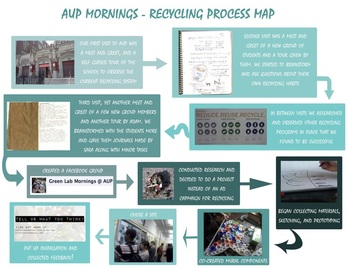Sustainability
Design Development: A Study of High School Sustainability in Action

For our Design Development class at Parsons in the spring of 2011, we were given the task of improving the recycling at the Academy of Urban Planning. AUP is a high school at the Bushwick Campus in Bushwick, Brooklyn. AUP is considered a recycling champion school according to the GrowNYC program, but our findings showed that there was still work to be done and room for improvement. While there were recycling bins in place around the school, many students, and even teachers, neglect them. Throughout our eight visits to AUP, we learned from our students and assessed the recycling situation at the school. With our group of sophomores, we worked to remedy the nonchalant attitudes towards recycling in the school community. AUP is located at the Bushwick Campus School in Bushwick, Brooklyn. AUP has a total of 427 students, mostly using the fourth and fifth floors of the building. The building also houses the Bushwick School of Social Justice and the Academy of Environmental Leadership. Bushwick’s population in 2007 was 129,980, 38.9% of that population was foreign born. In 2008 the neighborhood’s median household income was $28,802. 32% of the population falls under the poverty line, making Bushwick the 7th most impoverished neighborhood in New York City. Over 75% of children in the neighborhood are born in poverty. Figures from the NYC Department of Education indicate that the high school dropout rate in Bushwick is close to 70%.
Urban Dyeing - Rooftop Garden Project
Department Seminar: Sustainable Design
For this project, my teammates and I proposed a business plan for a CSA,
community supported agriculture, on Roosevelt Island in New York. We
decided to propose a CSA because we believed that community-supported
agriculture and eating local are very important for the community as well as the environment. Our mission was to promote health and
wellness on Roosevelt Island by bringing locally grown organic food to its
people. We believed that it was
also important to partner with community organizations for better promotion and
to raise awareness of the importance of locally grown products so that the
benefits of local food could be experienced for generations to come. We felt
that it was important to also differ from existing CSA’s in a number of ways. The first
being that we would offer single person shares instead of the
traditional full CSA shares that are for four person families only. We felt
this was important to make it more accessible to everyone because according to
our research 45% of households on the island were non-family households. We
also felt it was important to offer customizable shares and make them more
affordable. Too often people don’t participate in CSA’s or shop at local green
market because of the perceived, and often true notion that the ‘local business/green’
movement is too expensive for consumers.

